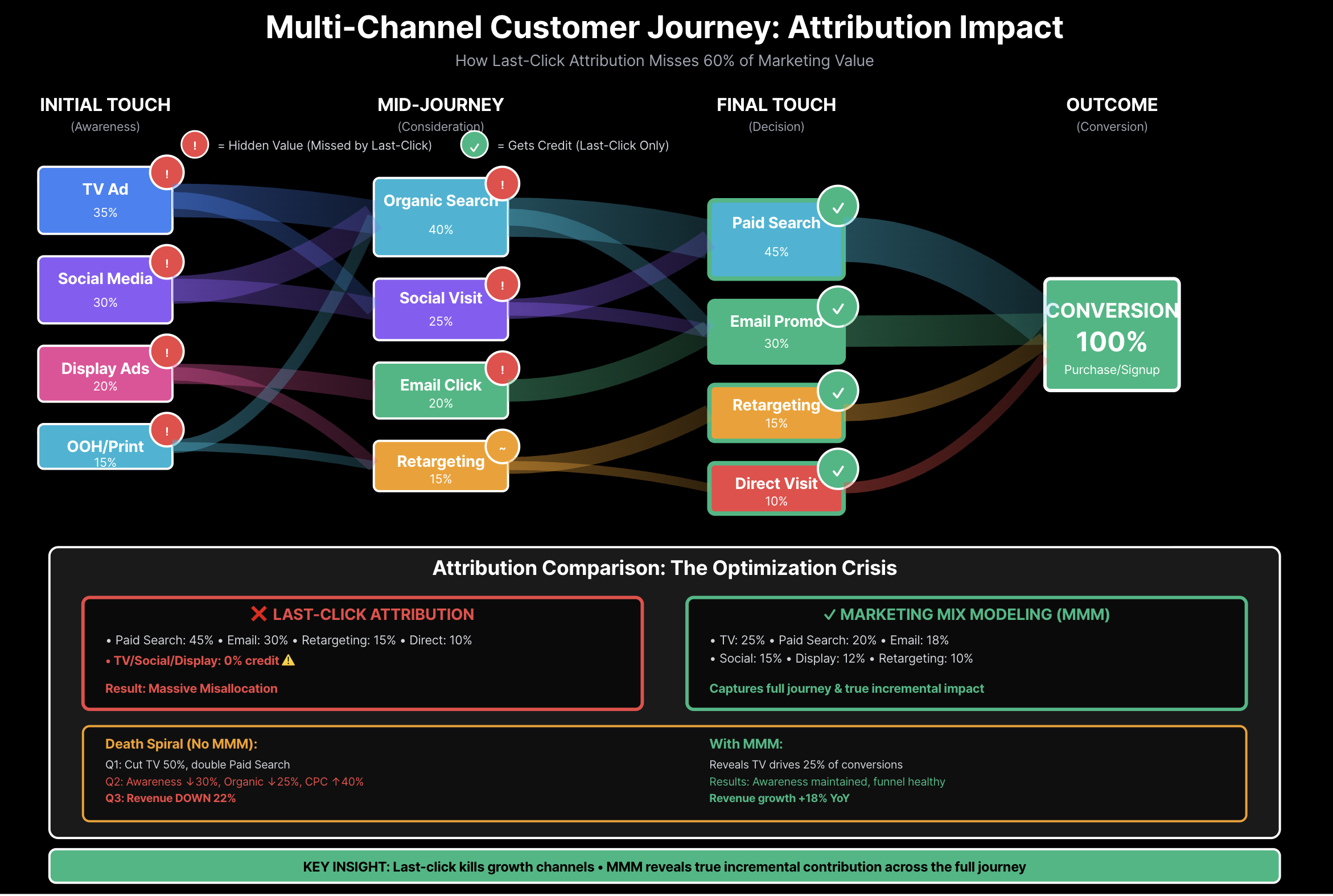Why Your Platform Attribution Tools are Lying to You (And Costing You Millions)
Most marketing dashboards show you fiction. Here's how to see the truth.
Your analytics platform says organic traffic drove $33,388 in revenue last month. Reality? Only $23,394 of that was actually organic. The rest was paid marketing showing up as "organic" in your reports.
This isn't a data quality issue. It's a fundamental flaw in how traditional attribution works—and it's causing business owners and marketing teams to make revenue limiting ad spend decisions.
The Attribution Illusion
Traditional analytics platforms use last-click attribution by default. When a customer sees your TV ad, searches for your brand three days later, and converts, your dashboard credits "organic search" with 100% of the revenue.
The TV ad that created the demand? Invisible - ghost-like if you will.
The result: You think organic is performing better than it is, paid channels look worse than they are, and you start cutting the channels that are actually driving your growth.
This pattern repeats across every channel. Paid search captures demand created by brand campaigns. Email takes credit for conversions that retargeting primed. Direct traffic gets attributed to word-of-mouth when it was actually triggered by a social ad someone saw last week.
You're not measuring marketing performance – You're measuring who happened to be last in line.

The 60/40 Problem
Here's what most companies miss: roughly 60% of your revenue comes from organic growth, brand equity, and market trends. The other 40% is your paid marketing's true incremental contribution.
But traditional attribution platforms can't separate these. They lump everything together and credit whichever touchpoint was last, creating a distorted picture that leads to terrible decisions that impact growth, planning, and revenues.
When you optimize based on last-click data, you unknowingly defund the awareness and consideration channels that fill the top of your funnel. Three months later, your "high-performing" bottom-funnel channels start struggling because there's no one left to convert.
How GhostReach Reveals True Performance
GhostReach solves this by establishing your organic growth baseline first. We use Marketing Mix Modeling to isolate what would have happened without your paid marketing—the natural momentum from product quality, brand reputation, word-of-mouth, and market dynamics.
Once we establish that baseline, with AI models we can measure the true incremental impact of each paid channel. Not correlation. Not last-click. Actual cause and effect.
The difference is dramatic. Companies using GhostReach typically discover:
- Their "organic" revenue is 20-50% lower than reported (much of it was paid-influenced)
- Their paid channels are delivering 30-40% more value than attributed
- Some "underperforming" channels are actually their growth engines
- Their best ROAS comes from channels they were about to cut
What You Actually See
GhostReach gives you side-by-side attribution: what your traditional analytics platform shows versus what's actually happening.
Platform Attribution vs. Reality:
- ORGANIC_USERS: Platform says $33,388. GhostReach reveals $23,394 (54% over-credited)
- GOOGLE: Platform says $9,126. GhostReach reveals $3,771 (the rest came from other channels)
- FACEBOOK: Platform says $0. GhostReach reveals $3,457 (completely invisible before)
Then we break down your paid impact by platform, showing true ROAS for each channel—not the ROAS you'd see in ad platforms, but the actual incremental return after controlling for everything else happening in your business.
You also see your Paid vs. Trend split. Is 38% of your growth coming from paid marketing and 62% from organic momentum? Or is it 70/30? This ratio tells you whether you're under-investing in paid (leaving money on the table) or over-investing (hitting diminishing returns).
Optimization That Actually Works
Once you see true attribution, budget optimization becomes obvious. GhostReach shows you exactly where to reallocate spend for maximum impact:
- Reddit showing 24.71% response lift? Increase budget by $240/week.
- Bing at -3.01% response lift? Decrease by $248/week.
- TikTok delivering 62.88% lift from just $70/week? Scale to $180/week.
These aren't guesses based on last-click ROAS. They're recommendations based on actual incremental contribution, controlling for seasonality, competition, and all other marketing activities.
The Forecast Advantage
GhostReach also projects your future performance under different budget scenarios. Increase Facebook spend by 50%? We'll show you the predicted revenue impact with confidence intervals. Testing a major channel shift? Run the scenario first and see the likely outcome.
This is how you move from reactive optimization (cutting what looks bad in last-click) to strategic planning (investing based on true incremental impact).
Stop Optimizing Toward Failure
Every day you optimize based on last-click attribution, you're making your marketing less effective. You're shifting budget away from channels that build awareness and top of funnel and toward channels that capture existing demand. You're turning marketing into an auction battle for the same pool of ready-to-buy customers.
Eventually, you hit the wall: CPC keeps rising, conversion rates keep falling, and growth stalls—despite "optimizing" everything.
GhostReach shows you what's actually working so you can optimize for growth, not just efficiency. See your organic baseline. Measure true paid impact. Scale what genuinely drives incremental revenue.
Ready to see your real attribution? Start with GhostReach and discover which channels are actually driving your growth.
GhostReach.AI is a Modern AI Marketing Optimization platform that reveals true channel performance by separating organic growth from paid impact. Get started at ghostreach.ai
